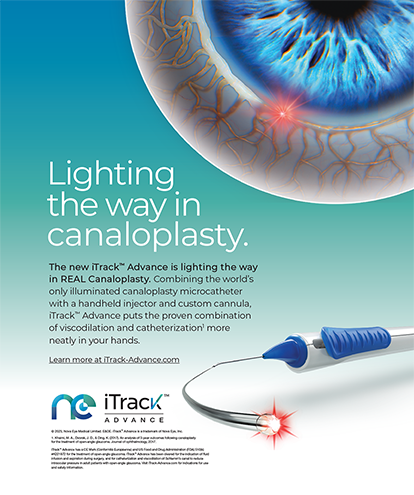Used in the 1970s, one of the earliest and most basic formulas for IOL power calculations was to take the precataract manifest refraction and add 19.00 D. Since then, we surgeons have seen the advent of many IOL formulas and biometric techniques that use sophisticated regression analysis and surgeon factors. Another useful tool now available is ORange intraoperative wavefront aberrometer (WaveTec Vision, Aliso Viejo, CA) and intraoperative wavefront refractions.
The following case report of a miscalculated IOL power demonstrates how to prevent IOL exchange surgery due to a postoperative refractive surprise.
HISTORY
A hyperopic 85-year-old male patient with a history of contact lens wear was diagnosed with cataracts and motivated to achieve the best possible distance vision without spectacles. The preoperative refraction was +3.50 +0.50 X 7 OD and +3.00 +1.00 X 173 OS. The readings were obtained with the IOLMaster (Carl Zeiss Meditec, Inc., Dublin, CA). The patient’s keratometry (K) readings were 44.58 X 45.67 OD and 43.55 X 44.58 OS. Axial length measured 23.69 mm OD and 23.74 mm OS. The preoperative IOL power calculated with the SRK/T formula was for the 19.50 D Hoya iSymm FC60- AD (Hoya Surgical Optics, Inc., Chino Hills, CA), with a predicted spherical equivalent (SE) of -0.41 D.
SURGERY
The surgery was uncomplicated. I used ORange intraoperative aberrometer to fine-tune the IOL choice. An aphakic refraction revealed +13.59 +1.56 X 154. ORange and the IOLMaster recommended a similar lens (Figure 1). The relative agreement of the devices confirmed the IOL’s power.
CONFLICT
I implanted a 20.00 D Hoya iSymm IOL. To check for residual cylinder and sphere, I performed a pseudophakic refraction with ORange while the patient was on the operating table. Surprisingly, the pseudophakic refraction revealed a hyperopic refraction of +1.92 +0.43 X 154, SE = +2.14 D. ORange measurement was repeated and again revealed the hyperopic refractive surprise (Figure 2).
RESOLUTION
I began to wonder if the IOL had been mislabeled. Was the pseudophakic refraction taken with ORange incorrect? Was the lens not sitting in the correct position? After deciding to trust the pseudophakic refraction, I removed the lens and repeated the aphakic refraction with ORange, which was consistent with the original aphakic refraction (Figure 3). After further deliberation, I decided to ignore the IOLMaster’s preoperative reading and the intraoperative aphakic refraction and chose an IOL based on the patient’s intraoperative pseudophakic refraction as per ORange. I made an adjustment to the IOL power to account for about 2.00 D of correction at the spectacle plane (roughly 3.00 D at the IOL plane) and placed a new IOL (+23.00 D). The patient’s final intraoperative pseudophakic refraction was -0.78 +1.02 X 153 (SE = -0.26 D) (Figure 4). This correlated with the final refraction in the chair of -0.25 +1.00 X 160.
WHAT HAPPENED?
Why was there an error? The patient’s preoperative refraction was +3.75 D. The axial length was appropriate for this refraction, but the preoperative K readings appeared to be relatively steep. Thus, the predicted power of the IOL was relatively small for such a hyperopic refraction. Based on the very rudimentary historical technique for calculating the power of the IOL mentioned earlier, I would have expected an IOL power of about 23.00 D. As it turns out, this method would have been more accurate than my calculations based on the IOLMaster or the ORange’s aphakic prediction. I decided that the K readings were the problem.
Prior to surgery on the patient’s second eye, he returned to the office for repeat measurements. This time, the patient’s Ks showed 41.82 @99 X 43.10 @9— a more appropriate reading—yielding a recommended IOL power of 23.00 D (to predict -0.31 D SE). Further investigation revealed that the patient had been wearing his contact lenses at the time of his initial biometry.
Obviously, taking a diagnostic biometry reading when the patient was wearing contact lenses resulted in erroneous K values, translating into an improperly selected IOL. An artificially steeper cornea led to an erroneous calculation using the IOLMaster. The aphakic predictions from ORange were also inaccurate secondary to the erroneous K value used. The current formula used in ORange’s aphakic calculations takes into account the patient’s preoperative K values. The device’s pseudophakic refraction, however, does not take into account preoperative K values, and thus it was able to discover the hyperopic surprise before I finished the case.
SUMMARY
Accurate predictions of the IOL’s power depend on correct K values. It is possible for a technician not to realize that a patient is wearing contact lenses and to inappropriately measure K values. Transcription errors are also possible. Artificially altered K values carry through to the patient’s postoperative refractive error unless, as in this case, the error is discovered in the OR with a pseudophakic calculation using ORange. A myopic patient wearing contact lenses when Ks were measured would have had artificially flat Ks, and thus, a more powerful lens woul
The historical method of calculating IOL power is a useful way of quickly double-checking the lens prior to implantation. Pseudophakic refractions with ORange can catch a variety of errors, including biometric, before the patient leaves the OR. Future aphakic formulas for predicting the IOL’s power on ORange will likely provide recommendations based solely on intraoperative information, which will not be subject to the translation of preoperative biometric errors.
William F. Wiley, MD, is in practice at the Cleveland Eye Clinic in Cleveland, Ohio. He acknowledged a financial interest in ORange and WaveTec Vision. Dr. Wiley may be reached at (440) 941-2020; drwiley@clevelandeyeclinic.com.


